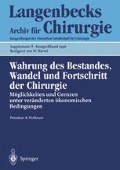Summary
Clinical studies and animal experiments have not yet reached a consensus on primary and unreamed medullary nailing in polytrauma, especially when craniocerebral and thoracic injuries are involved. Gaping plate osteosynthesis, a recognized technique for treating complex fractures, also represents, with our technique, an option in simple femoral stem fractures.
Zusammenfassung
Beim Polytrauma ist die primäre, auch ungebohrte Marknagelung bei Oberschenkelbrüchen in experimentellen Studien, besonders in Kombination mit SHT und Thoraxtrauma, umstritten. Die durchgeschobene, überbrückende Plattenosteosynthese ist in der vorgestellten Technik auch bei einfachen Bruchformen des Oberschenkels eine extramedulläre Alternative.
Access this chapter
Tax calculation will be finalised at checkout
Purchases are for personal use only
Literatur
Heim D, Regazzoni P, Tsakiris DA, Aebi T, Schlegel U, Marbet GA, Perren SM (1995) Intramedullary nailing and pulmonary embolism: Does unreamed nailing prevent embolisation? An in vivo study in rabbits. J Trauma 38:899
Kinast C, Bolhofner BR, Mast JW, Ganz R (1989) Subtrochanteric fractures of the femur. Results of treatment with the 95° condylar blade-plate. Clin Orthop Rel Res 238:122
Lehmann U, Reif W, Hobbensieken G, Seekamp A, Regel G, Sturm JA, Dwenger A, Schweitzer G, Mann D, Ellerbeck M, Tscherne H (1995) Der Einfluß der primären Frakturversorgung auf ein Schädel-Hirn-Trauma bei Polytrauma. Unfallchirurg 98:437
Neudeck F, Obertacke U, Wozasek G, Thurnher M, Schlag G, Schmit-Neuerburg KP (1994) Patho-physiologische Konsequenzen verschiedener Osteosyntheseverfahren beim Polytraumatisierten. Teil 1. Akt Traumatol 24:114
Stürmer KM, Schuchhardt W (1980) Neue Aspekte der gedeckten Marknagelung und des Aufbohrens im Tierexperiment. IL Der intramedulläre Druck beim Aufbohren der Markhöhle. Unfallheilkd 83:346
Author information
Authors and Affiliations
Editor information
Editors and Affiliations
Rights and permissions
Copyright information
© 1996 Springer-Verlag Berlin Heidelberg
About this paper
Cite this paper
Knopp, W., Schmidtmann, U., Stürmer, K.M. (1996). Die überbrückende Plattenosteosynthese bei einfachen Femurfrakturen — eine minimal-invasive Methode beim Polytrauma. In: Hartel, W. (eds) Wahrung des Bestandes, Wandel und Fortschritt der Chirurgie. Langenbecks Archiv für Chirurgie, vol 1996. Springer, Berlin, Heidelberg. https://doi.org/10.1007/978-3-642-80295-9_252
Download citation
DOI: https://doi.org/10.1007/978-3-642-80295-9_252
Publisher Name: Springer, Berlin, Heidelberg
Print ISBN: 978-3-540-61617-7
Online ISBN: 978-3-642-80295-9
eBook Packages: Springer Book Archive

